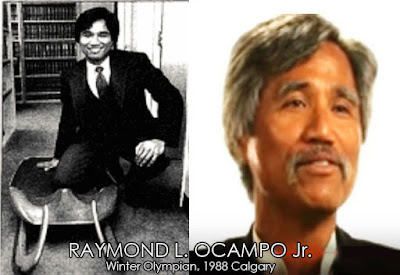SKI IS NO LIMIT. Lawyer-luger Raymond Ocampo Jr. did not just want to compete in the Olympics, he wanted to race for the Philippines, his country of birth. But his dream was put in peril due to passport issues. Photo: NY Times,
When a topnotch Kapampangan-American athlete and lawyer
was asked in one job interview which he would prioritize—to handle a major
corporate client or to compete in the Olympic, he chose the latter—and got
hired anyway. Such is the commitment of Raymond
L. Ocampo Jr. to his chosen discipline—luge—a winter sport that is hardly
known in the U.S., much less in the Philippines. But Ocampo did not just want
to join the Winter Olympics; he
wanted to compete for the Philippines.
It had been 16 years since the Philippines was
represented in a winter Olympics; the
first time was in the 1972 Sapporo games
when cousins Ben Nanasca and Juan Cipriano competed in alpine skiing.
The two were adopted and lived in Andorra,
and took to skiing in the Pyrenees.
They became so proficient that the Swiss government recruited them for an
alpine skiing group, which paved the way for their Olympic stint under the
Philippine flag.
Ocampo’s
journey was unlike our pioneer Olympians. Born in Lubao on 10 Feb. 1953, his parents migrated to Canada when he was 11. The young Ocampo channeled his energies into
sports of all kinds—as a high-schooler, he became a member of his school’s
basketball team that won the state championship. Even as a political science
student at UCLA and later, as a law
student, he was running marathons in
between poring over legal tomes.
After passing the bar, Ocampo went into private practice and continued with his love of
sports. In 1986, the year he got employed by Oracle Corp., he became fascinated with luge—a fast race on
artificial ice tracks using racing sleds that could be maneuvered to reach over
140 kilometer per hour.
What was amazing was that Ocampo learned the sports from scratch. He would watch old video
tapes of past winter Olympics editions, but when he reviewed the Saravejo Olympics of 1984, he was
surprised to learn that tropical Puerto
Rico was represented by a skier named George
Tucker. He seriously began entertaining the thought of representing the
country of his birth.
First, Ocampo
began investing in the sport, spending as much as $20,000 alone for trips and
equipment. He started intensive dry-land training on a sled with wheels and joining
races. His first big one was at the Empire State Games at Lake Placid in 1986, finishing a
creditable 7th in his over-30 age group. One of those he defeated
was Puerto Rican George Tucker! The
experience buoyed his confidence and thus began his personal mission to ski for the Philippines.
But first, he needed the permission of the Philippine Olympic Committee in Manila via the Philippine Consulate in San
Francisco. It took awhile to convince sports officials that his application
was valid: the International Olympic
Committee allows an athlete to represent the country of his birth so long
as he has not competed in the same sport
for another country. Besides, as a dual Filipino-American citizen, he
was eligible to don the Philippine tri-color.
The national committee however, required him to hold a
Philippine passport first—and thus began a series of frustrating passport
issues that imperiled his Olympic dream. ''Luging is hard enough,'' he
realized, but ''the paper trail was the hardest part.'' A personnel from the
consulate volunteered to take his case, and his cache of supporting documents
to Manila to discuss his request
with the Olympic committee.
But the official’s timing was bad; Corazon Aquino had just ousted Marcos, and a new government was
being put in place. It did not help that the official had strong ties with the
Marcos administration, so upon landing in Manila, he was withheld, and his
papers were confiscated, including Ocampo’s
pertinent documents. The disappointed Olympic hopeful had to start all over.
Ocampo
personally sent a letter to Vice
President Salvador H. Laurel. He sent another letter to Sec. Gen. Francisco Almeda—who had denied his
first request. The United States Luge
Federation even sent a letter of recommendation to convince the Olympic
committee. When still a deluge of letters and telex messages from Ocampo were left unanswered, the weary
athlete phoned Almeda directly,
finally convincing him how serious he was. With that final go-signal, Ocampo
gave a big sigh of relief as he mused: ''It was an exhausting process…more exhausting
than lugeing.''
When the 15th
Winter Olympics unfolded in Calgary,
Alberta, Canada on 13 February 1988, the triumphant Ocampo marched into the McMahon
Stadium, proudly holding the
Philippine flag up high. He was the lone Filipino among the thousands of international
athletes who congregated in Calgary
that year to vie for medals in the premiere winter sport games of the world.
Never has there been an athlete who have worked and
prepared as hard as Raymond L. Ocampo Jr.—even before the Games had
started. ''A medal is not something I'm shooting for,'' the Kapampangan-American
said. ''But whether I win one or not, it would be nice to bring a focus to the
Philippines for something other than the troubles they have been having. That's
just the way I feel.''
(POSTSCRIPT: Ocampo was fielded in the men's
singles luge event and finished 35 out of 38 overall. In 2010, he served as an honorary
captain of the U.S. Olympic Luge Team that competed in Vancouver,Canada. He is
the current President and CEO of Samurai Surfer LLC, a private consulting and
investment company)
SOURCES:
Raymond L. Ocampo Jr. , https://www.bloomberg.com/research/stocks/private/person.asp?personId=667210&privcapId=338154
OLYMPIC PROFILE: RAYMOND OCAMPO; One-Man Luge Team With
Tale of 2 Flags, By MICHAEL JANOFSKY, Nov. 29, 1987, https://www.nytimes.com/1987/11/29/sports/olympic-profile-raymond-ocampo-one-man-luge-team-with-tale-of-2-flags.html
Pictures: https://www.h5.com/ray-ocampo-jr/
New York Times, Nov. 29, 1987










